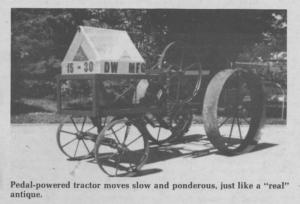Tractor Shows How Old Engines Work
 ✖  |
"More and more people come to threshing bees and engine shows with little working knowledge of the machines they see. They're impressed wth the size and noise but can't really appreciate the skill, hard work and knowledge that goes into restoring and operating these old engines," says Dick Wenkel, who built a pedal-powered "training tractor" that demonstrates some of the principles that drive many old antique tractors.
The tractor is an approximately 1/3-scale pedal-powered antique. Wenkel collected parts from junked equipment, including manure spreaders, potato diggers and even some stuff from his wife's sewing basket. The wheels came from an old corn planter and the heavy flywheel is the pulley from a water pump.
The frame was riveted together and welding kept to a minimum so that construction would closely resemble "real" antiques. The "engine's" crankshaft turns about three times as fast as the pedals. The "transmission" consists of a chain drive from the pedal to a counter shaft with a small pinion gear which meshes with a large internal ring gear on the rear axle. The transmission gears the pedal shaft down 7 to 1 on the rear axle. The ground speed, which is about 1 1/2 mph., can be varied by changing the sprocket on the pedal shaft. The pedal shaft sprocket is held with a set screw which can be loosened to allow the tractor to be used for belt work, just like an old time model. Wenkel also built a scaled-down saw that can be driven by the tractor.
The tractor's overall length is 6 1/2 ft. and its width 3-1/3 ft. Height is 3 1/2 ft. and it weighs 280 lbs. Like antique tractors, the model designation 15-30 means 15 drawbar horsepower and 30 hp. on the belt.
"It handles like old tractors, slow and ponderous. The horizontal screw and its chain steering forces the driver to anticipate corners. It has enough size and weight so that it's not a toy," says Wenkel.

Click here to download page story appeared in.
Click here to read entire issue
Tractor Shows how old engines Work TRACTORS Made-It-Myself 9-2-35 "More and more people come to threshing bees and engine shows with little working knowledge of the machines they see. They're impressed wth the size and noise but can't really appreciate the skill, hard work and knowledge that goes into restoring and operating these old engines," says Dick Wenkel, who built a pedal-powered "training tractor" that demonstrates some of the principles that drive many old antique tractors.
The tractor is an approximately 1/3-scale pedal-powered antique. Wenkel collected parts from junked equipment, including manure spreaders, potato diggers and even some stuff from his wife's sewing basket. The wheels came from an old corn planter and the heavy flywheel is the pulley from a water pump.
The frame was riveted together and welding kept to a minimum so that construction would closely resemble "real" antiques. The "engine's" crankshaft turns about three times as fast as the pedals. The "transmission" consists of a chain drive from the pedal to a counter shaft with a small pinion gear which meshes with a large internal ring gear on the rear axle. The transmission gears the pedal shaft down 7 to 1 on the rear axle. The ground speed, which is about 1 1/2 mph., can be varied by changing the sprocket on the pedal shaft. The pedal shaft sprocket is held with a set screw which can be loosened to allow the tractor to be used for belt work, just like an old time model. Wenkel also built a scaled-down saw that can be driven by the tractor.
The tractor's overall length is 6 1/2 ft. and its width 3-1/3 ft. Height is 3 1/2 ft. and it weighs 280 lbs. Like antique tractors, the model designation 15-30 means 15 drawbar horsepower and 30 hp. on the belt.
"It handles like old tractors, slow and ponderous. The horizontal screw and its chain steering forces the driver to anticipate corners. It has enough size and weight so that it's not a toy," says Wenkel.
To read the rest of this story, download this issue below or click
here to register with your account number.







